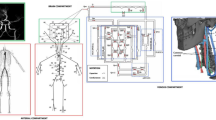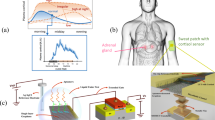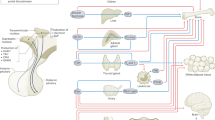Abstract
Plasma levels of β-endorphin, vasopressin and Cortisol during head-up tilt were measured in tetraplegic patients and in normal healthy subjects. In tetraplegic patients rapid tilt from the horizontal to 30° or 60° head-up induced orthostatic hypotension and increased plasma levels of Cortisol, β-endorphin and vasopressin. In control subjects head-up tilt failed to alter plasma levels of these hormones. These data show that the head-up position in tetraplegics causes various endocrine reactions.
Similar content being viewed by others
Log in or create a free account to read this content
Gain free access to this article, as well as selected content from this journal and more on nature.com
or
References
Akil H, Watson S J, Young E et al 1984 Endogenous opioids: biology and function. Annual Review of Neuroscience 7: 223–255.
Faden A, Holaday J W 1979 Opiate antagonists: a role in the treatment of hypovolemic shock. Science 205: 317–318.
Faden A, Holaday J W 1980 Naloxone treatment endotoxic shock: stereospecificity of physiologic and pharmacologic effects in the rat. Journal of Pharmocology and Experimental Therapeutics 212: 441–447.
Faden A, Jacobs T P, Holaday J W 1980 Endorphin-parasympathetic interaction in spinal shock. Journal of the Autonomic Nervous System 2: 295–304.
Figoni S F, 1984. Cardiovascular and haemodynamic responses to tilting and to standing in tetraplegic patients: A review. Paraplegia 22: 99–109.
Johnson R H, Park D M 1973. Effect of change of posture on blood pressure and plasma renin concentration in men with spinal transection. Clinical Science 44: 539–546.
Kamelhar D L, Steele J M, Schacth R G, Lowenstein J, Naftchi N E 1978 Plasma renin and serum dopamine β-hydroxylase during orthostatic hypotension in quadriplegic man. Archives of Physical Medicine and Rehabilitation 59: 212–220.
Kooner J S, Frankel H L, Mirando N, Peart W S, Mathias C J 1988 Haemodynamic, hormonal and urinary responses to postural change in tetraplegic and paraplegic man. Paraplegia 26: 233–237.
Mathias C J, Christensen N J, Corbett J L et al 1975 Plasma catecholamines, plasma renin activity and plasma aldosterone in tetraplegic man, horizontal and tilted. Clinical Science 49: 291–299.
Mathias C J, Christensen N J, Frankel H L, Peart W S, 1980 Renin release during head-up tilt occurs independently of sympathetic nervous activity in tetraplegic man. Clinical Science 59: 251–256.
Martin W R 1984 Pharmacology of opioids. Pharmacological Reviews 35: 283–323.
Rein I A, Schwartz J 1984. Role of vasopressin in the control of blood pressure. In: Martini L, Ganong WF (eds) Frontiers in Neuroendocrinology. Raven Press, New York, pp 177–197.
Polinsky R J, Brown R T, Lee G K et al 1987 β-Endorphin, ACTH, and Catecholamine response in chronic autonomic failure. Annals of Neurology 21: 573–577.
Stephen F F 1984 Cardiovascular and haemodynamic responses to tilting and standing in tetraplegic patients: A review. Paraplegia 22: 99–109.
Sved A F, Fletcher H M D, Blessing W W 1985 Release of antidiuretic hormone in quadriplegic subjects in response to head-up tilt. Neurology 35: 78–82.
Author information
Authors and Affiliations
Rights and permissions
About this article
Cite this article
Özcan, O., Ulus, I., Yurtkuran, M. et al. Release of vasopressin, cortisol and β-endorphin in tetraplegic subjects in response to head-up tilt. Spinal Cord 29, 120–124 (1991). https://doi.org/10.1038/sc.1991.16
Issue date:
DOI: https://doi.org/10.1038/sc.1991.16
This article is cited by
-
Leg vascular resistance increases during head-up tilt in paraplegics
European Journal of Applied Physiology (2005)



